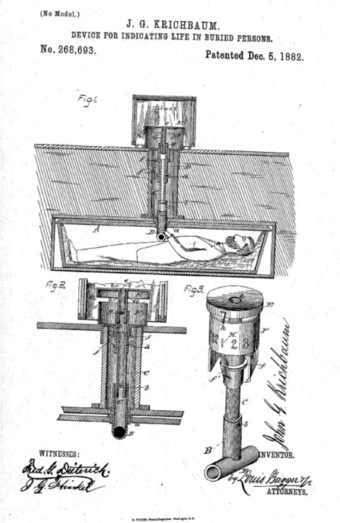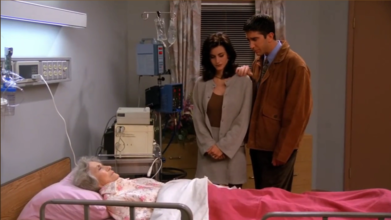- Health Conditions A-Z
- Health & Wellness
- Nutrition
- Fitness
- Health News
- Ayurveda
- Videos
- Medicine A-Z
- Parenting
Medical Memoir: Were Dead Truly 'Saved By The Bell' Before The Modern Guidelines Of Declaring Someone Dead Evolved?

Credits: Canva and Snapshot from The Autopsy Of Jane Doe with bell tied with a deceased's ankle
Remember when in the Ep 8 of Season 1, Friends, Ross's 'nana' or grandmother dies and then wakes up again? Well, only to die a few moments later. However, she did rise from death. What if we tell you there is a science behind it? It is called the Lazarus Phenomenon or the Lazarus Syndrome, which we will come back later.
Few fears in history have been as chilling as the thought of waking up six feet under. Long before modern medical technology, the line between life and death was frighteningly blurry.
Without stethoscopes, electrocardiograms, or ventilators, doctors relied on mirrors held under the nose, or fingers pressed against a wrist, to declare someone dead. Mistakes were inevitable.
Accounts from as early as the 14th century suggest this nightmare was not unfounded. When the tomb of philosopher John Duns Scotus was reportedly opened, his body was discovered outside his coffin, his hands torn in a way that suggested he had tried to claw his way free. Coming back to another popular culture reference in the movie The Autopsy of Jane Doe, there is a mention of how dead bodies have bells tied to their ankle to ensure they are truly dead. This is a practice rooted deeply in history to avoid accidental burial.
READ: Medical Memoir: The Accidental Development Of The Small Pox Vaccine
Taphophobia: Accidental Deaths
Centuries ago, in 17th-century England, Alice Blunden of Basingstoke collapsed after drinking poppy tea, which acted as a sedative. Declared dead, she was buried swiftly. Days later, children heard noises near her grave. By the time she was exhumed, she was still clinging to life, but ultimately perished after a second premature burial.
Such tragedies gave rise to a cultural obsession known as taphophobia, the fear of being buried alive. The anxiety was so widespread that it inspired not only literature, such as Edgar Allan Poe’s haunting 1844 story The Premature Burial, but also a wave of bizarre inventions designed to save the mistakenly entombed.
Coffin Bells and Safety Devices

The 19th century saw one of the strangest solutions: the grave bell. In cemeteries like Cooper Cemetery in Ohio, a pipe was installed leading from the coffin to the surface, with a string tied to the corpse’s hand. At the surface, the string connected to a bell fixed to a post. If the “deceased” stirred, they could tug the string and ring for rescue.
Local historians believe this system may have inspired the phrase “saved by the bell.” Graveyards often stationed watchmen nearby, waiting to see if a bell would ring in the night. While the eerie sound must have sent shivers down spines, it was, for some, a last hope of survival.

Inventors soon took the concept further. Patents from the 1800s detail elaborate “safety coffins” equipped with air pipes, escape ladders, and signaling devices. Franz Vester’s 1868 “Improved Burial Case” included a bell and ladder for the unfortunate soul who awoke underground.
John Krichbaum’s 1882 design featured a T-shaped pipe that moved with hand motion, signaling life above ground. Others included clockwork fans for fresh air, or even battery-powered alarms to alert caretakers.
Though many of these designs were never widely adopted, they reflected the pervasive fear of premature burial in an era when medical certainty was elusive.
Accidentally Declared Dead Even In Modern Times
Even in modern times, stories of mistaken burials continue to surface. In 2011, Fagilyu Mukhametzyanov of Russia woke up during her own funeral. She opened her eyes in her casket, surrounded by grieving relatives. She screamed, was rushed to the hospital, and lived for another 12 minutes before dying of heart failure.
In 2014, Walter Williams of Mississippi was declared dead, his body zipped into a bag and delivered to a funeral home. To the embalmer’s shock, Williams’ legs began moving. He was breathing lightly and had, in fact, survived his first “death.” Two weeks later, however, he passed away for good.
These unsettling stories remind us that the fine line between life and death is sometimes blurrier than we’d like to admit.
The Lazarus Phenomenon: “Returns” from Death
If premature burial was the horror of the past, the Lazarus phenomenon, named after the Biblical figure who rose from the tomb, represents today’s medical equivalent.
Also Read: 71-Year-Old Declared Dead, But Came Back Alive: How Science Explains This Shocking Revival
Lazarus syndrome is the spontaneous return of circulation after failed attempts at resuscitation. In other words, a person’s heart restarts after doctors have already stopped CPR and pronounced them dead.
Documented only around 63 times in medical literature, it remains vanishingly rare. Most cases occur within ten minutes of resuscitation efforts ending.
Theories include:
Air trapping: Too much air pumped into the lungs during CPR builds pressure in the chest, preventing blood flow. When CPR stops, the pressure drops, and the heart spontaneously restarts.
Delayed medication delivery: Drugs given during resuscitation sometimes take effect only after circulation resumes.
Defibrillation delays: A shock to the heart may take longer than expected to trigger a rhythm.
Real-life examples are just as dramatic as tales of grave bells. In Detroit, a 20-year-old woman was declared dead after 30 minutes of CPR, only for funeral home staff to notice her breathing. In Britain, a 23-year-old man began breathing again after last rites. In Ohio, a man’s family watched in shock as his heart rhythm returned minutes after he had been declared dead.

Though survival rates are low, most patients die again soon after, just like it happened with 'Nana' from Friends.
Death: A Process, Not an Instant
What connects premature burial and Lazarus syndrome is a simple truth: death is not always an immediate event. Instead, it is a process in which organs gradually fail. Historically, without medical monitors, it was almost impossible to distinguish deep coma or catalepsy from actual death. Today, despite advanced machines, the Lazarus phenomenon shows that even modern medicine occasionally falters.
Medical guidelines now recommend waiting at least ten minutes after CPR stops before officially declaring death, ensuring that spontaneous circulation will not return. It is a safeguard rooted in the same caution that once drove inventors to attach bells to coffins.
As Winter Flu Spreads, Pharmacist Says Be Ready With These 4 Medicines

Credits: Canva
While December arrives with celebrations, food and social gatherings, it is also the time when seasonal illnesses quietly begin to surface. Colds, lingering coughs and flu tend to spread more easily in colder weather, often catching people off guard just as the new year begins. For those hoping to avoid starting January feeling unwell, there are simple steps that can be taken ahead of time.
A pharmacist has urged people to prepare early by stocking up on essential remedies, saying that being organised can help manage symptoms quickly and reduce unnecessary visits to the doctor. According to him, early action makes winter illnesses far easier to handle.
Why Pharmacists Say Preparation Matters Before January
Pharmacists say the key to getting through winter comfortably is preparation before cold and flu season reaches its peak. Keeping a well-stocked medicine cupboard means symptoms can be treated as soon as they appear, without the stress of searching for supplies while already feeling ill.
“Preparation really is half the battle,” said pharmacist Frederick Apenteng from Roseway Labs. “Once you’re unwell, the last thing you want is to be running around looking for paracetamol or trying to buy a thermometer. That’s often when people feel worse than they need to.”
Medicines To Get Ready For Winter Flu
Frederick stresses that starting with the basics is essential. Painkillers such as paracetamol or ibuprofen help manage fever, aches and general discomfort. Throat lozenges or sprays can ease soreness, while keeping two types of cough medicine at home is helpful. One should be an expectorant for chesty coughs, and the other a suppressant for dry, irritating coughs.
The Basics Every Household Should Have
Blocked noses are another common winter complaint, and decongestants can provide quick relief. However, Frederick warns they should not be used for more than five days. For longer-term congestion, saline nasal sprays are a safer option.
Other useful items include rehydration sachets, tissues, hand sanitiser, and honey and lemon for comfort. A digital thermometer allows you to keep track of fever, while vapour rubs or a humidifier can help ease breathing when congestion strikes.
Why Nutrition and Rest Matter for Immunity
Beyond medicines, Frederick highlights the role of nutrition in keeping the immune system strong. “People often feel run down because they’re missing key nutrients,” he explained. “Iron, B vitamins and vitamin C all play important roles in supporting immune defences.”
Eating foods rich in these nutrients, such as leafy greens, citrus fruits and whole grains, can make a noticeable difference. “The biggest immunity boosters are actually sleep, proper nutrition and staying hydrated,” he added.
A Little Planning Now Can Prevent Bigger Problems Later
Preparing in advance can ease both physical discomfort and mental stress. “Having your winter kit ready means you can act quickly at the first sneeze,” Frederick said. “That can stop symptoms from getting worse and helps keep you out of the GP waiting room.”
In short, early rest, basic treatment and preparation can help people move through winter with fewer disruptions.
Be Cautious With Cold and Flu Medicines
While home remedies can be helpful, it is important not to overuse certain products. In some cases, taking too many cold and flu medicines can cause serious problems, including accidental overdose, liver or kidney damage, and rebound congestion.
Always follow dosage instructions carefully and speak to a healthcare professional if you are unsure. Frederick also cautions against prolonged use of nasal decongestant sprays. Using them for more than a few days can trigger a rebound effect, where nasal passages become more blocked than before. This condition is known as rhinitis medicamentosa.
Staying informed, prepared and cautious can make all the difference during the winter months.
Adenovirus Incubation Period: How Long Does It Take For Symptoms To Appear?

Credits: Canva
If you managed to stay healthy this festive season, chances are you still know at least a couple of people who did not. In the days before Christmas and in the weeks that followed, a so-called “mystery virus” has been moving rapidly across the UK.
Many people have reported coughing, sneezing, blocked or runny noses, and in some cases stomach-related problems too. So what exactly is behind this wave of illness? Ian Budd, lead prescribing pharmacist at Chemist4U, has explained which virus is currently spreading widely across the country and what steps you can take to safeguard yourself and your family. He also sheds light on its incubation period.
What Is Adenovirus?
Adenoviruses refer to a large family of viruses that can trigger infections ranging from mild to more serious, affecting different parts of the body. Most often, adenovirus targets the respiratory tract. The symptoms can closely resemble those of a cold or flu. In the majority of cases, adenovirus infections are mild and can be managed with basic care focused on easing symptoms.
Adenovirus Incubation Period
The incubation period for adenovirus usually falls between 2 and 14 days. For many people, signs such as fever, a sore throat, or coughing tend to appear around five or six days after coming into contact with the virus, although this can differ from person to person. Adenovirus spreads easily through droplets released when someone coughs or sneezes, by touching contaminated surfaces, or through fecal-oral transmission. It is highly contagious, particularly in crowded settings, and people may continue to shed the virus even after they start feeling better, according to the National Institute of Health.
One reason the virus appears to be everywhere right now is winter behaviour. Colder weather keeps people indoors for longer periods, increasing close contact with others who may already be unwell.
Ian explained, “With COVID-19 restrictions no longer in place and fewer people being exposed to common viruses over the last few years, overall immunity in the community may be lower. That makes people more vulnerable now.
“Adenovirus itself is not new. It is simply appearing more frequently at the same time as other winter illnesses.”
Adenovirus Symptoms
If you suspect you may have adenovirus, the most common symptoms include:
- Sore throat
- Runny or blocked nose
- Cough
- Fever
- Fatigue
- Headaches or body aches
- Shortness of breath, which is less common
Other possible signs:
- Pink eye, also known as conjunctivitis, causing red, watery, gritty-feeling eyes
- Ear infections, particularly among children
- Digestive symptoms such as nausea, vomiting, or diarrhoea with certain strains
Who Do Adenoviruses Affect?
Adenoviruses can infect people at any age, but they are especially common in children under the age of five. In babies and young children, the virus often spreads in daycare settings, where close contact is unavoidable. Young children are also more likely to put shared objects in their mouths and are less consistent about handwashing.
Among adults, adenoviruses tend to spread in crowded living conditions. Those who spend time in dormitories or military housing may face a higher risk. The virus can also circulate easily in hospitals and nursing homes.
People with weakened immune systems are more likely to become seriously ill if they contract adenovirus. This group includes individuals who have undergone stem cell or organ transplants, as well as those living with cancer or HIV/AIDS. Those with existing heart or lung conditions also face a higher risk of severe infection.
After Weight-Loss Injections, Some Women Are Seeking Costly Vaginal Cosmetic Surgery

Credits: Canva
Women are spending thousands of pounds to address an intimate and largely unexpected side effect linked to rapid weight loss caused by so-called “fat jabs.” As these injections grow quickly in popularity, doctors say sudden and significant weight loss is leading some women to notice changes in their labia or vulva.
This has resulted in a rise in private cosmetic procedures commonly referred to as “labia puffing.” For those unversed, the vulva refers to the external female genital area, which includes the labia. The labia are the folds of skin that surround the vaginal opening.
Weight-Loss Injections Go Mainstream
Originally developed to manage Type 2 diabetes, weight-loss injections have entered the mainstream at remarkable speed. As per Mirror, in the UK alone, about 2.5 million people are now using these drugs, according to figures reported by The Telegraph in October. That means roughly one in every 20 adults. Most users access the injections privately, as they are rarely available through the NHS. The report also noted that sales of medications such as Mounjaro and Wegovy reached 2.5 million in July, marking a sevenfold increase compared to the previous year.
While headlines have largely focused on visible changes such as slimmer bodies and faces, including among celebrities like Sharon Osbourne and Serena Williams, medical professionals say other, less discussed effects are starting to emerge.
Changes Beyond Common Side Effects
Along with widely known side effects such as nausea, diarrhoea, constipation, abdominal pain, and vomiting, some women are now reporting noticeable changes in the appearance of their vulvas and labia.
Doctors explain that the issue is not weight loss itself, but the speed at which it happens. Rapid weight loss strips fat from many areas of the body, including the vulval region. For some women, this leads to a loss of volume in the labia, causing loose or sagging skin. This can result in irritation and discomfort during everyday activities such as sitting, cycling, or exercising.
Women Share Their Experiences
Many women have taken to online forums to describe what they are experiencing. As per Mirror, one Reddit user shared, “She [the gynaecologist] told me my vulva is saggy and I will continue to experience pain when biking or sitting unless I have surgery or fillers.”
Doctors say these outcomes are not surprising. Dr Michael Tahery, writing on his women’s health website, explained that “the rapid weight loss that occurs throughout the body may result in visible sagging of the labia or vagina because of overall fat and volume loss.”
He added that this sagging can be caused by loose labia, excess skin in the vaginal area, wrinkles, or a combination of these factors. “It’s also common for rapid weight loss to cause the labia to suddenly feel out of proportion compared to how it previously felt,” he noted.
Not Just a Cosmetic Concern
For many women, the impact goes beyond appearance. The loss of natural cushioning can increase friction and sensitivity, turning once-comfortable activities into painful experiences. As a result, more women are seeking help from private clinics, where corrective procedures can cost around $2,000, or approximately £1,479. The treatment, often called labia puffing, focuses on restoring volume to the outer lips of the vulva.
What Is Labia Puffing?
Speaking to The Daily Star, Dr Shazia Malik, consultant gynaecologist at The Portland Hospital, explained how the procedure works. “Labia puffing uses dermal fillers, such as hyaluronic acid or fat, to restore volume to the labia majora, which are the outer lips of the vulva,” she said. “It is a minimally invasive procedure designed to improve appearance by increasing fullness, smoothness, and symmetry.”
Dr Malik also pointed out that the demand is not limited to women using weight-loss injections. “The procedure is most commonly sought by women who want to regain a more youthful, fuller appearance due to ageing, weight loss, or childbirth,” she explained.
A Wider Impact of Rapid Weight Loss
The growing interest in these procedures highlights how dramatically weight-loss injections can change the body. Unlike gradual weight loss achieved through diet and exercise, the speed at which fat can disappear with these drugs means changes can occur in areas people do not expect. For some women, these sudden shifts are significant enough to push them toward cosmetic interventions to feel comfortable again.
© 2024 Bennett, Coleman & Company Limited

